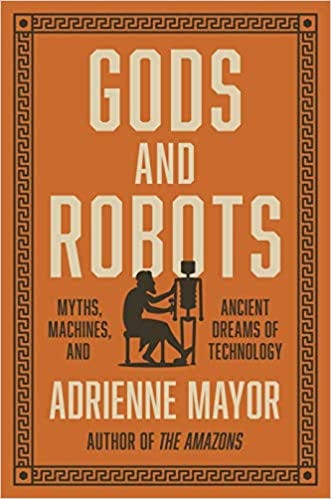
The Greeks were the first in recorded history to discuss machines that think. Adrienne Mayor, a research scholar at Stanford University, has written a book about how the concept of artificial life seeps into ancient myths. Her book is called ‘Gods and Robots: Myths, Machines and Ancient Dreams of Technology’.
In the book she explores how AI can be seen in the works of Homer and Hesiod. This news bulletin from Stanford University describes some of the myths she writes about.
The myth describes Talos as a giant bronze man built by Hephaestus, the Greek god of invention and blacksmithing. Talos was commissioned by Zeus, the king of Greek gods, to protect the island of Crete from invaders. He marched around the island three times every day and hurled boulders at approaching enemy ships. At his core, the giant had a tube running from his head to one of his feet that carried a mysterious life source of the gods the Greeks called ichor. Another ancient text, Argonautica, which dates to the third century B.C., describes how sorceress Medea defeated Talos by removing a bolt at his ankle and letting the ichor fluid flow out, Mayor said.
The myth of Pandora, first described in Hesiod’s Theogony, is another example of a mythical artificial being, Mayor said. Although much later versions of the story portray Pandora as an innocent woman who unknowingly opened a box of evil, Mayor said Hesiod’s original described Pandora as an artificial, evil woman built by Hephaestus and sent to Earth on the orders of Zeus to punish humans for discovering fire. “It could be argued that Pandora was a kind of AI agent,” Mayor said. “Her only mission was to infiltrate the human world and release her jar of miseries.”
As I write this, I’m thinking about the Antikythera mechanism and to further explore what ancient technology was actually in existence and whether these myths had any truth to them.
However, not until the birth of computing could the concept of AI begin to be realised.
The genius Alan Turing (of breaking the Nazi’s ENIGMA code fame) tried to answer the question of whether machines can think in his ‘Computing Machinery and Intelligence’ paper. The famous Turing Test comes from this paper, which is a way to determine whether a machine’s intelligent behaviour is equal to, or indistinguishable from, a human. It was originally called the imitation game, which is where the title of the 2014 film with Benedict Cumberbatch and Keira Knightley came from.
Fast-forward to today and AI is on the verge of pervading every aspect of our lives. Currently, AI is predominantly used for problem-solving, using machine learning and algorithms, however as the field expands, greater oversight and ethical discussions over its use are needed.
An example of how dangerous AI can be, either on its own, or in the hands of bad actors can be seen in the design of medicines. Furthermore, the designers and owners of a particular AI technology may not even realise the implications of their designs until it is too late. This is perfectly exemplified in the following case study, whereby the company in question admit they were naïve for not thinking how their trade could be misused.
The rest of this article is for paid subscribers only. If you want to read the rest of this article about AI creating bioweapons then please subscribe to my newsletter. My articles take a lot of time to research and write so your support is very much appreciated and will ensure that I can continue to produce the same quality and quantity of articles going forwards.
Keep reading with a 7-day free trial
Subscribe to The Naked Emperor’s Newsletter to keep reading this post and get 7 days of free access to the full post archives.



